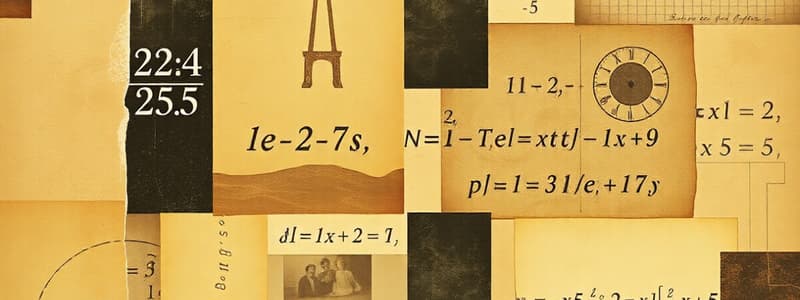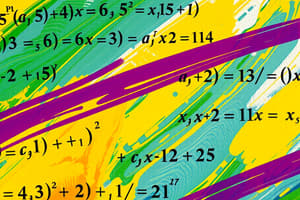Podcast
Questions and Answers
What is the primary goal when solving an equation?
What is the primary goal when solving an equation?
- To rewrite the equation in standard form.
- To isolate the variable on one side of the equation. (correct)
- To find the value of any constant in the equation.
- To combine all terms into one term.
Which of the following correctly identifies the format of a linear equation?
Which of the following correctly identifies the format of a linear equation?
- y = mx + b. (correct)
- y = ax + b.
- x = m + b.
- y = m + bx.
What describes the degree of a polynomial?
What describes the degree of a polynomial?
- The highest coefficient in the polynomial.
- The number of terms in the polynomial.
- The total number of variables present in the polynomial.
- The highest exponent of the variable in the polynomial. (correct)
Which method is commonly used for factoring polynomials?
Which method is commonly used for factoring polynomials?
Which of the following equations represents a quadratic equation?
Which of the following equations represents a quadratic equation?
What determines whether the graph of a quadratic function opens upwards or downwards?
What determines whether the graph of a quadratic function opens upwards or downwards?
Which of the following represents a common method for solving quadratic equations?
Which of the following represents a common method for solving quadratic equations?
What type of function assigns each input value to exactly one output value?
What type of function assigns each input value to exactly one output value?
In the context of sequences and series, what distinguishes a geometric sequence from an arithmetic sequence?
In the context of sequences and series, what distinguishes a geometric sequence from an arithmetic sequence?
What does the term 'vertex' refer to in the graph of a quadratic function?
What does the term 'vertex' refer to in the graph of a quadratic function?
Flashcards
Algebraic Expression
Algebraic Expression
A combination of variables, constants, and mathematical operations.
Equation
Equation
A mathematical statement that two expressions are equal.
Linear Equation
Linear Equation
An equation that graphs as a straight line, has the form y = mx + b.
Quadratic Equation
Quadratic Equation
Signup and view all the flashcards
Variable
Variable
Signup and view all the flashcards
Quadratic Equation Solutions
Quadratic Equation Solutions
Signup and view all the flashcards
Parabola's Shape
Parabola's Shape
Signup and view all the flashcards
Function's Assignment
Function's Assignment
Signup and view all the flashcards
Matrix Definition
Matrix Definition
Signup and view all the flashcards
Algebra's Application
Algebra's Application
Signup and view all the flashcards
Study Notes
Basic Concepts
- Algebra is a branch of mathematics using symbols and variables to represent numbers and quantities in mathematical expressions and equations.
- Variables (like 'x' or 'y') represent unknown values.
- Constants are fixed numerical values in an expression.
- Terms are individual parts of an expression (e.g., 3x, 5).
- Expressions combine terms (e.g., 2x + 3).
- Equations state that two expressions are equal (e.g., 2x + 3 = 7).
- Inequalities show that one expression is greater than, less than, or not equal to another (e.g., x > 5).
- Arithmetic properties (commutative, associative, and distributive) apply to algebraic expressions.
Solving Equations
- Solve equations by isolating the variable on one side.
- Use inverse operations to undo operations on the variable.
- Example: if 'x' is added to 5, subtract 5 from both sides.
- Example: if 'x' is multiplied by 2, divide both sides by 2.
- Equations often require multiple steps.
- Check solutions by substituting the solved value into the original equation.
Linear Equations
- Linear equations graph as straight lines.
- They have the form 'y = mx + b', where 'm' is the slope and 'b' is the y-intercept.
- Slope shows the line's steepness and direction.
- Y-intercept is the point where the line crosses the y-axis.
- Linear equations model relationships between variables.
- Systems of linear equations are solved graphically or algebraically (substitution/elimination).
Polynomials
- Polynomials are algebraic expressions with variables and constants, combined using operations like addition, subtraction, multiplication, and non-negative integer exponents.
- Examples include x² + 2x + 1.
- The degree of a polynomial is the highest exponent.
Factoring
- Factoring expresses a polynomial as a product of polynomials.
- Common factoring finds the greatest common factor of terms.
- Difference of squares is a factoring pattern for differences of two squares in an expression.
Quadratic Equations
- Quadratic equations have the form 'ax² + bx + c = 0', where a, b, and c are constants.
- Solve using factoring, completing the square, or the quadratic formula.
- Solutions can be real numbers (intersection with the x-axis) or complex numbers (no intersection with the x-axis).
Quadratic Functions
- Quadratic functions graph as parabolas.
- Parabola opens upwards or downwards based on the 'a' coefficient's sign.
- The vertex of a parabola is its highest or lowest point.
- Graph parabolas by finding the vertex and plotting points.
Exponents and Radicals
- Exponents represent repeated multiplication of a base.
- Radicals represent roots (e.g., square root, cube root).
- Rules for exponents and radicals simplify and manipulate expressions.
Functions
- A function maps each input to exactly one output.
- Functions can be represented by equations, tables, graphs, or descriptions.
- Domain and range are crucial in function analysis.
- Examples include linear, quadratic, polynomial, exponential, and logarithmic functions.
Matrices and Vectors
- Matrices are rectangular arrays of numbers.
- Vectors have magnitude and direction.
- Matrix and vector operations are used in various fields.
Sequences and Series
- Sequences and series deal with ordered lists of numbers.
- Arithmetic and geometric sequences are common types.
- Series sum the terms in a sequence.
Applications of Algebra
- Algebra models real-world situations and solves problems.
- It represents relationships between variables.
- It provides a framework to analyze and interpret data.
Studying That Suits You
Use AI to generate personalized quizzes and flashcards to suit your learning preferences.




